Jay and Silent Bob Strike Back appears in an aspect ratio of approximately 2.35:1 on this single-sided, double-layered DVD; the image has been enhanced for 16X9 televisions. While the picture betrayed a few concerns, as a whole it looked quite good and it offered the strongest image of any Smith DVD to date.
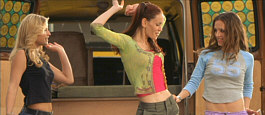 Sharpness looked quite positive. At all times, the image remained nicely crisp and distinct. I detected no signs of softness or fuzziness, and the picture seemed well defined. Jagged edges and moiré effects caused no concerns, and I saw no signs of edge enhancement. In regard to print defects, I witnessed some light grain at times and a few specks of grit, but overall, the movie was essentially free of defects.
Sharpness looked quite positive. At all times, the image remained nicely crisp and distinct. I detected no signs of softness or fuzziness, and the picture seemed well defined. Jagged edges and moiré effects caused no concerns, and I saw no signs of edge enhancement. In regard to print defects, I witnessed some light grain at times and a few specks of grit, but overall, the movie was essentially free of defects.
Colors generally appeared nicely bright and vivid, but they weren’t consistently terrific. At times I thought they looked a little heavy and murky, though those concerns appeared infrequently. Usually the tones were fine, however. Black levels also came across as deep and rich, while shadow detail was appropriately heavy and lacked any overly thick sequences. Overall, Jay and Silent Bob Strike Back provided a solid picture with only a smattering of minor issues to lower my grade to a “B+”.
Also fairly satisfying was the Dolby Digital 5.1 soundtrack of Jay and Silent Bob Strike Back. The soundfield generally revealed a forward bias, as the imagery remained fairly heavily anchored in the front channels. That domain showed solid stereo presence, as music spread neatly across the speakers and effects also appeared well placed and accurate. Different elements blended together well, and they moved cleanly and smoothly across the environment. Surround usage usually stayed with general reinforcement of music and effects, but I heard a reasonable amount of distinct audio. Explosions and vehicles created a nice rear presence, and the overall impression left by the track was of a clear and acceptably engulfing piece.
Audio quality also came across positively. I heard a little edge for a few lines, but generally I thought speech appeared natural and distinct, and I discerned no problems related to intelligibility. Music seemed bright and vibrant, with solid range heard in the score and the various songs; all were well reproduced and dynamic. Effects showed similar qualities, as they appeared vivid and clear at all times; I heard no distortion or any flaws related to those elements. The track also boasted some positive bass response, as low end sounds consistently appeared deep and tight. Despite a few small issues, Jay and Silent Bob Strike Back provided a good sonic experience as a whole.
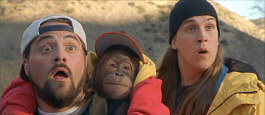 Let’s take a look at the supplements grades I assigned for the five prior Kevin Smith-related DVDs I reviewed. Clerks: B+. Mallrats: A. Chasing Amy: B+. Clerks Animated: A. Dogma: A-. Notice a pattern here? When it’s a Smith project, you know the DVD will include some terrific extras, and Jay and Silent Bob Strike Back is no exception.
Let’s take a look at the supplements grades I assigned for the five prior Kevin Smith-related DVDs I reviewed. Clerks: B+. Mallrats: A. Chasing Amy: B+. Clerks Animated: A. Dogma: A-. Notice a pattern here? When it’s a Smith project, you know the DVD will include some terrific extras, and Jay and Silent Bob Strike Back is no exception.
In fact, it may well be the best of the bunch. The two-DVD set packs in scads of supplements, the majority of which seem quite interesting. Most of these appear on the second disc, but we do discover a few bits on DVD One. Actually, we only get one extra on that platter: an audio commentary from Smith, producer Scott Mosier, and actor Jason Mewes. Some fans expressed disappointment over this crew, as the DVD offers a smaller gang o’ speakers than many other Smith affairs; only the “technical commentary” for Dogma also included three participants, as all the others featured at least six people per track. To be sure, it’d be nice to have Ben Affleck along for the ride, but nonetheless, this is still another fun and informative Smith commentary.
Not surprisingly, Smith dominates; that was the case with all the others as well. However, after a slow start, Mosier gives him a run for his money. Mewes tosses in the occasional stoner aside but doesn’t offer much. Smith and Mosier offer a nice mix of the technical and the creative, as they cover a variety of issues from production challenges to working with castmembers to changes made in the script. I was surprised that no one mentioned the Pee-wee’s Big Adventure homage, but they went over pretty much everything of interest. As always, Smith is frank and funny, and we learn cool tidbits like Carrie Fisher’s problems with Mewes and her refusal to allow any Star Wars references in her scenes. It’s not the best of the View Askew tracks, but it’s still very good.
(As an aside, I was surprised no one mentioned the blatant Pee-wee’s Big Adventure references. The entire third act openly steals from that 1985 classic; they clearly acknowledge this when Bob and Jay encounter a familiar-looking bicycle.)
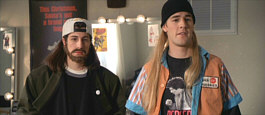 Unlike most Disney-distributed DVDs, Silent Bob doesn’t open with any “forced trailers”. However, we do find a selection of ads within the Sneak Peeks domain. It includes ads for the current (as I write this) theatrical release of 40 Days and 40 Nights plus Smith offerings Clerks, Chasing Amy and Clerks Uncensored. It also provides promos for the Silent Bob soundtrack and Dimension’s “Cutting Edge” films.
Unlike most Disney-distributed DVDs, Silent Bob doesn’t open with any “forced trailers”. However, we do find a selection of ads within the Sneak Peeks domain. It includes ads for the current (as I write this) theatrical release of 40 Days and 40 Nights plus Smith offerings Clerks, Chasing Amy and Clerks Uncensored. It also provides promos for the Silent Bob soundtrack and Dimension’s “Cutting Edge” films.
Also on Disc One we find some DVD-ROM materials. Most intriguing is the Open Mic Commentary. This allows you to add your own statements for any of nine different scenes from the flick. Since I don’t have a microphone for my computer, I couldn’t participate myself, but I was able to check out the different fan commentaries found on the website. I listened to a smattering of them and yes, the majority seem to be just as lame as you might expect. Do I really need to hear some loser rant about how sexy Shannon Elizabeth is? Intriguingly, the site mentions that commentaries from cast and crew will appear eventually, but right now, it just features inane fan tracks.
While I suppose the Screenplay Viewer should be self-explanatory, I’ll explain it anyway. In standard fashion, the film appears in a box on the left of the screen, while text runs on the right. Nothing new here, but it’s fun nonetheless to examine the various alterations made from script to screen. A weblink to the official site also appears.
That finishes the first disc, so we now move to DVD Two, where the lion’s share of the supplements reside. Clearly the biggest attraction of this platter are the 42 Deleted Scenes. No, that’s not a typo - there really are 42 excised segments found here! As will be the case with many of DVD Two’s extras, each of these launches with an introduction from Smith and/or a rotating cast of others such as Mosier, Mewes, Smith’s wife Jennifer Schwalbach and daughter Harley Quinn, and actor Walt Flanagan. Including the intros, this domain lasts a whopping 93 minutes and 45 seconds.
That’s a lot of cut footage, but don’t expect tons of totally deleted material. The vast majority of the trims came from scenes that made the movie; we mainly find extended versions here. Since the intros take up a lot of time, I’d estimate that the actually cuts amount to no more than half this program and possibly less once we factor in bits that did find their way into the movie.
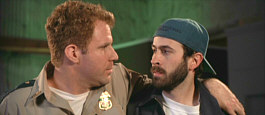 As such, the running time is a little misleading, but it’s still a solid collection. There’s some entertaining material to be found here, even though most of it merited omission. Some of the trims came to satisfy the MPAA, but others occurred for pacing and various other reasons. The intros are consistently amusing and actually might be more fun than the deleted scenes themselves. In any case, this is a nice package that makes a good addition to the disc.
As such, the running time is a little misleading, but it’s still a solid collection. There’s some entertaining material to be found here, even though most of it merited omission. Some of the trims came to satisfy the MPAA, but others occurred for pacing and various other reasons. The intros are consistently amusing and actually might be more fun than the deleted scenes themselves. In any case, this is a nice package that makes a good addition to the disc.
Up next is a Gag Reel. After a 63-second intro from Smith and Mewes, we get seven minutes and 32 seconds of the usual flubs and mistakes. Most of this revolves around errors and laughing, but I must admit I like the variations on Mewes’ nasty raps, so it’s worth a look.
The Still Galleries break down into three domains. We find “On the Set” (122 shots), “Birth of a Poster” (54 pictures), and “Jay and Silent Bob Comics” (74 pages). The first is decent but nothing special, as it packs in the usual images from the set. The other two are significantly more interesting, though the comics will be less useful for those who already own them. We see excerpts from one magazine, and it’s fun to read. The poster stills are very cool, as they go through a myriad of different options. My only complaint stemmed from the presentation; the posters didn’t fill as much of the screen as they could/should have. Nonetheless, it’s a nice package of good material.
The Secret Stash includes a collection of outtakes, all of which are grouped into different domains. There’s “Judd Nelson in ‘Let’s Go Back to the Station House’”, “Ham Affleck”, “Will and Jon and the CLIT”, and “The Genius of Will Ferrell”. All come with Smith/Mewes/Mosier intros; all told, the package lasts 10 minutes and 20 seconds. There’s some entertaining material here, but I didn’t think any of it was terrifically funny.
Within the Internet Trailers domain we locate two ads created specifically for the web. Smith and Mewes introduce the first but not the second. Surprisingly, no theatrical trailers appear, but we do get six TV Spots as well.
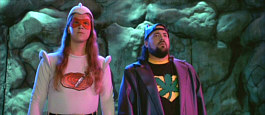 The Behind the Scenes Featurette lasts 13 minutes and 35 seconds and offers a fairly standard program. It combines the standard mix of shots from the set, sound bites from participants, and clips from the movie - lots of clips from the movie. Actually, the latter weren’t too overwhelming; the piece seemed promotional as a whole, but it also added some decent interview bits and a fair amount of cool material from the set. We also get some neat factoids, such as other actors proposed to play Matt Damon and Ben Affleck. It’s not a great featurette, but it’s definitely above average for the format.
The Behind the Scenes Featurette lasts 13 minutes and 35 seconds and offers a fairly standard program. It combines the standard mix of shots from the set, sound bites from participants, and clips from the movie - lots of clips from the movie. Actually, the latter weren’t too overwhelming; the piece seemed promotional as a whole, but it also added some decent interview bits and a fair amount of cool material from the set. We also get some neat factoids, such as other actors proposed to play Matt Damon and Ben Affleck. It’s not a great featurette, but it’s definitely above average for the format.
Less compelling is Comedy Central’s Reel Comedy: Jay and Silent Bob Strike Back. As you might guess, this 21-minute and 55-second show originally aired on the cable network. It operates like most other “making of” programs, with one exception; we find interviews from Mewes and Smith in character as Jay and Silent Bob. That’s about the only clever aspect of “Reel Comedy”, as it otherwise offers a pretty fluffy promotional piece. There’s some funny material but nothing special.
Within the Storyboards domain we locate a collection of 240 different drawings. Most of these revolve around an alternate - and much more graphic - Scooby Doo sequence, and there’s also a moderately different orangutan escape bit as well as some variations on the Planet of the Apes material. I usually don’t care much for storyboards, but these cartoons are a lot of fun, primarily because they show some material that didn’t make the film. (We see a little of this in the “Deleted Scenes” domain, but the storyboards still contain some unshot footage.)
The next two pieces relate to Jay and Silent Bob’s favorite band. Morris Day and the Time: Learnin’ the Move provides a 115-second glimpse at some dance training. We see Mewes and the rhythmically challenged Smith get some lessons from Day and Jerome Benton. It’s brief but very entertaining. Guide to Morris Day and the Time offers a surprisingly detailed biography of the band. The text program provides a nice recap of their career. (A mildly different version appears in Disc One’s DVD-ROM area; it also shows a mix of still photos and a sound clip for “Jungle Love”.)
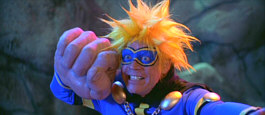 Within Music Videos, we find two clips. There’s Afroman’s “I Got High” as well as Stroke 9’s “Kick Some Ass”. The former offers some new shots of Mewes and Smith in character and is substantially more entertaining than the average rap video, though the comedic clip loses some of the song’s value as a cautionary tale. As for the latter, it shows lip-synch shots of the band and also features Jay and Bob as they exact physical violence against popular performers (or their lookalikes, at least). It’s somewhat witless and predictable, but it’s still more amusing than most videos.
Within Music Videos, we find two clips. There’s Afroman’s “I Got High” as well as Stroke 9’s “Kick Some Ass”. The former offers some new shots of Mewes and Smith in character and is substantially more entertaining than the average rap video, though the comedic clip loses some of the song’s value as a cautionary tale. As for the latter, it shows lip-synch shots of the band and also features Jay and Bob as they exact physical violence against popular performers (or their lookalikes, at least). It’s somewhat witless and predictable, but it’s still more amusing than most videos.
Next we get Cast and Crew Filmographies. Most sections of this sort simply provide basic listings of flicks, but this one goes a little farther. We find brief biographical trivia about Smith, producer Mosier, cinematographer Jamie Anderson, composer James L. Venable, and actors Mewes, Shannon Elizabeth, Ben Affleck, Eliza Dushku, Chris Rock, Will Ferrell, Jason Lee, Ali Larter, Seann William Scott, Diedrich Bader, George Carlin, Carrie Fisher and Mark Hamill. (Note that an altered version of this appears in Disc One’s DVD-ROM area: the trivia’s shorter there, but each actor’s section also includes sound bites and still photos.)
That last domain includes an Easter egg, though I’m not sure how many people will actually want to see it. If you go to Mewes’ listing and click “up”, you’ll highlight the word “balls”. Hit “enter” and you’ll see an alternate take that lives up to its billing. Not something I’d like to watch again.
But I’ll definitely check out Jay and Silent Bob Strike Back for additional screenings. Despite my initial dislike of the flick when I saw it theatrically, I’ve found that it grew on me, and I enjoyed it quite a lot more during my second assessment. The DVD provides consistently positive picture and sound plus a terrific assortment of extras. The View Askewniverse comes to a close with yet another fine DVD that I highly recommend.

